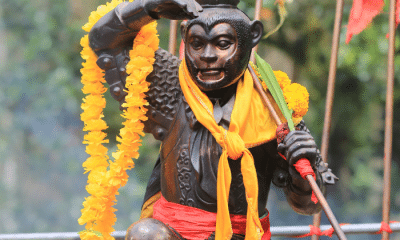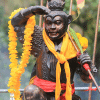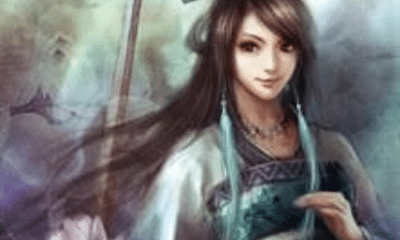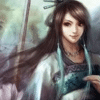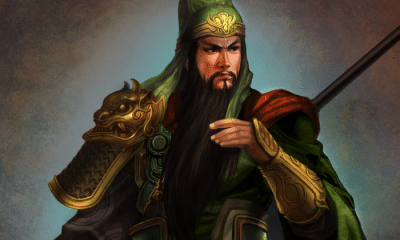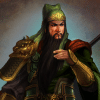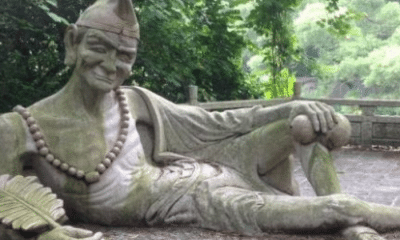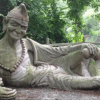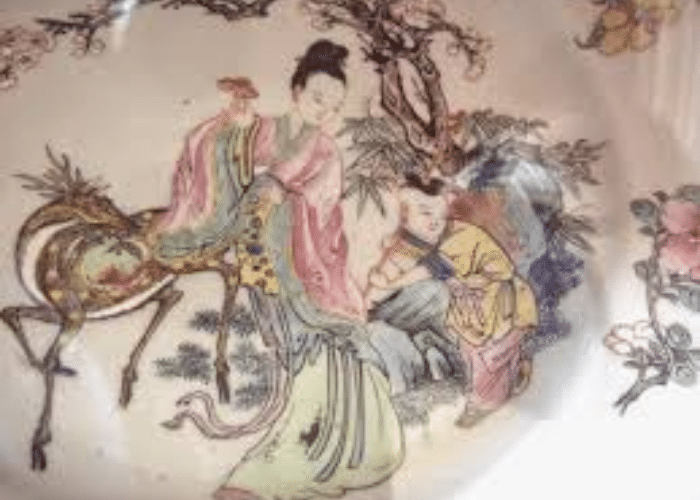
Chinese
Xiwangmu: The Queen Mother of the West
Xiwangmu: The Queen Mother of the West
Xiwangmu was one of the oldest goddesses in the Chinese pantheon. Keep reading to learn how she went from being an enigmatic personification of danger to the queen of wealth and divinity.
Five hundred years before Homer penned the Iliad, an anonymous seer in China carved a prayer into a bone. In it, they asked for the goddess of the West to guide their prophecies.
Two thousand years later, this goddess was still considered a source of wisdom. Despite major changes to not only her own character but also to the region’s religion as a whole, the Queen Mother of the West was still thought to rule from her mountaintop home.
Over this long history, Xiwangmu was reimagined. The terrifying goddess of early Chinese thought became a regal figure who gave wisdom, longevity, and legitimacy to the rules of kings.
The reasons for this change have as much to do with where the goddess lived as they do with Chinese religion as a whole. The West, always a place of danger and mystery, became a region of great power.
The Ancient Goddess Xiwangmu
The goddess Xiwangmu was known by many names throughout Chinese history and in the languages of other Asian cultures. In the West, she is most often called by a calque, or loan translation: The Queen Mother of the West.
The earliest references to a goddess with this identification are among the oldest written records in China. An oracle bone dating from at least 1200 BC calls upon “the eastern mother and the western mother” in divination.
The earliest images are from just a few hundred years later. She was shown as a ferocious, disease-causing goddess with the sharp fangs of a tiger.
Later images and writings, however, depicted her in a much different way. By the 4th century BC, she was described as a being who had accepted Taoism and been accepted among the immortal divinities.
Over a thousand years later, the Queen Mother of the West became a popular figure in the era’s rich poetry. In the early 10th century, Du Guangting compiled the most complete collection of Xiwangmu’s legends in “Records of the Assembled Transcendents of the Fortified Walled City.”
While these poems only reflect how the Queen Mother of the West was viewed during the final years of the Tang Dynasty, a brief period in her long record, they provide the first real indication of a mythology and personality for the goddess.
The Tang era Xiwangmu lived on the mythical western Mount Kunlun. Although a real place now bears this name, it was only called Kunlun after these poems had been written.
Her palace was a perfect paradise. It was a peaceful meeting place for the gods and a powerful conduit that allowed communication between Heaven and Earth.
At Mount Kunlun, the Queen Mother presided over an entirely female court. Goddesses and feminine spirits formed her whole retinue.
Mount Kunlun had been established not after the queen’s supposed adoption of the Tao as a center of learning, trade, and culture. While no men lived there, many leaders and sages supposedly visited the legendary mountaintop palace.
One of the most well-known legends is that of King Mu, one of the greatest rulers of the Zhou Dynasty. In the 10th century BC, he supposedly traveled to Kunlun to learn from Queen Mu.
The journey to the West proved that the king had a mandate to rule over all of China, and when he reached Kunlun he gave the Queen many of the nation’s most valued treasures. They had a love affair but when the time came for him to return to his home he did not receive the immortality he had hoped for.
Another emperor, Qin Shi Huang, was invited to learn from the Queen but turned down the opportunity. He passed by his chance at attaining immortality and died without the Divine Mandate that the journey conveyed.
The stories of Xiwangmu’s meetings with mortal kinds follow a pattern. The rulers are honored with her presence but fail to learn her teachings, thus losing their chance to gain godhood themselves.
The Tang poets believed that women had great success under the Queen Mother’s patronage.
Xiwangmu was said to support the aspirations of all women who followed the Tao. Unlike men, who had to be exceptional rulers to study under her, she would grant inspiration and clarity to women at any level.
The wisdom and independence of the all-female Western court made the Queen a unique figure in the highly patriarchal society of China. She represented the highest power of yin, the feminine force, and was sometimes taken as an inspiration for women who did not fit societal norms of submission and dependence.
Finally, Xiwangmu was envisioned as a goddess of longevity.
In poetry, she often served her divine guests peaches. Her home was said to be near the orchard that provided the Peaches of Immortality.
These peaches were so closely associated with her that they were often shown hanging from her headdress. From a terrifying plague goddess, the Queen Mother of the West was transformed into one that gave longevity.
My Modern Interpretation
The reason for Xiwangmu’s transformation from a goddess who brought disease to one who exemplified wisdom and longevity is tied to the expansion of Chinese culture.
Through much of its history, royal power was consolidated in the East. With few exceptions, the fertile river valleys and the long shoreline of Eastern China provided the culture with its wealth and prosperity.
The West, however, was a place of mystery and dangers. Rugged mountains and plateaus made the terrain nearly unpassable. Deserts prevented travel further west for anyone who managed to find a pass through the mountains.
Early manifestations of the Queen of the West did not specify how far she lived in that direction, but tradition soon placed her home among the region’s highest peaks. To most people in early China, this would have been as remote a place as they could imagine.
For this reason, the original goddess was thought of as being intimidating and ferocious. As the deity of a land that few could survive in, she was as dangerous as the mountains she lived in.
Taoism, however, changed this view. When it replaced earlier animistic and shamanistic beliefs, it put more emphasis on the virtues of divine beings. Immortality was not a birthright, but a state reached through exceptional virtue.
For followers of a philosophy that emphasized study and the wisdom of tutors, it was easy to picture Xiwangmu as being in possession of knowledge that could not be found in the East.
Taoists would undertake the perilous journey through the mountains to gain this wisdom. Xiwangmu’s legends, however, made it clear that her lessons were of no use if her students did not put them into practice when they returned to their homelands.
The journey was also a sign that a king had a Divine Mandate for rule.
This belief held that certain kings were granted authority over all of China by the gods. One way to prove the legitimacy of such a claim was to physically cross the entire kingdom.
Reaching Kunlun not only signaled that a king was a student of the Tao, but also that he had the right to rule all of China, not only the East.
The Queen Mother gained her association with longevity not only by teaching her students how to become immortals. It was also one of her chief virtues.
A long life was a sign that a person had learned the Tao and put its teaching into practice. It was not only a gift to be given by the gods, but also a sign of a person’s own virtues.
In many cases, longevity was considered a form of prosperity. The two concepts were so closely linked that many deities of old age and long life were also thought to provide wealth and luck.
Xiwangmu would become intrinsically linked to wealth when a road was finally established through Western China’s harsh landscape.
This trade route became the Silk Road. It linked the Empire of Eastern China to the Near East and from there to European markets.
The once mysterious land of the West became a gateway to new sources of wealth and prosperity. The journey was still difficult, but merchants who made the long trek West were guaranteed a rich payout by making it.
The mountains of the West were eventually seen as less of a barrier and more of a gateway. The West, and the goddess who ruled it, came to be associated with prosperity through trade, the mandate to rule, and a source of otherwise hidden wisdom.
In Summary
The western goddess is one of the first known deities to be explicitly mentioned in texts from early Chinese history. Earlier than 1000 BC she was invoked in divination rituals.
The earliest known iconography of this goddess shows a figure that was to be feared. She had sharp fangs and brought diseases to anyone who crossed her.
This was in keeping with her home in the West. In contrast to the fertile river valleys and bountiful shoreline of the East, the mountains and deserts of Western China were mysterious, dangerous, and foreboding.
When Taoism caused people to reconsider the goddess’s virtues, however, she came to be associated with the sages and tutors that spread the new philosophy’s teachings.
Those who were willing to undergo the trek to the West had a chance at attaining immortality by studying under her. While the kings that did so did not practice her teachings enough to gain this boon, they did prove their power over the land by reaching its farthest edges.
Xiwangmu was therefore associated with immortality and was often shown with the peaches that granted eternal life. Longevity, however, was also a form of prosperity.
This association became clear when the Silk Road opened a route through the Queen’s mountains to the markets of the Near East and Europe. This new source of wealth still held dangers, but those who braved it would be rewarded handsomely by the goddess.


